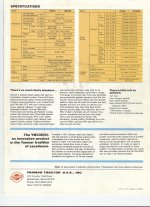Thanks for the replies.
California, thanks for mentioning the difference on 6.00x12 and 6-12 tires. The R1 thread is a must, I use my loader and am in muddy conditions quite a bit.
RScotty, I used manufacturer listed RCI numbers for calculations.That being the case, does it look like I got it in the ballpark.
Darryl, I just don't know what to say. If you did use the manufacturers numbers for Rolling Circumference - which is abbreviated RC or sometimes RCI for Rolling Circumference Index, then your calculations are correct.
But what makes me unsure is that in all your previous posts - including the one in Parts and Repair - you didn't mention RC at all. You said that you were using "circumference". Used alone that way, the word "circumference" typically means arithmatic circumference (pi times diameter).
If you are confident that all your numbers are indeed rolling circumference throughout, then yes, the calculations are correct.
Lets delve a littlle deeper into the "why" of ratio matching. You should think this through, because with lugged tires matching the front to rear ratio becomes more difficult. Think about it this way: with turf or industrial tires, the rolling circumference is about the same regardless of the soil type because the tires don't sink in. But with big lugs in mud, tires can sink in so far that using them in muddy versus hard soil affects the rolling circumference and therefore the ratio match.... a lot.
Large construction machines and some offroad vehicles can have lug tires and work ok in sloppy soils with dry stretches inbetween because they are using a different additional way to protect the drivetrain from windup. Their designers know that a single ratio match doesn't cover all the bases,
so those machines either have a fluid coupling in the driveshaft(s) or an additional center differential between the front and rear axles.
But compact tractors don't have that extra layer of drivetrain protection. That's because they are simpler, and are derived from farm tractors which were nott originally built to carry loads in the first place. Compacts were built to PULL loads through sloppy soils with a 3pt hitch, not to carry weight out in front in a loader. PULLING loads allows for easy tire slippage, carrying loads does the opposite. When you put a loader on a tractor, you have to not only get the F/R ratio right, you have to pay attention to some other clues... It can work, but needs more operator input to use 4wd intelligently when the only protection for the entire drivetrain is in making the tires slip.
So with lugged tires and a loader used in both muddy and hard surfaces, the important thing is not the ratio match so much as why you are trying to match the ratio in the first place. You are matching so that you can avoid windup in the drive train.
Are you? Are you getting windup? If not, or if you are dealing with it, then you may already be OK. After all, you've had the new rears on for a few weeks now. How does it steer and how difficult is it to shift into and out of 4wd? Those are the clues to whether the ratio is close enough for use - especially in slippery conditions.
If you suspect that the ratio is way out of whack, only use 4wd sparingly at low speed and just to get through the tough spots and then immediately shift back to 2wd when you get traction. If you do that religiously then tire slippage will protect the drive train no matter how far out the ratio is.
rScotty
